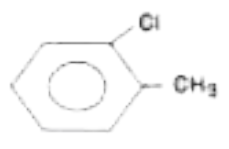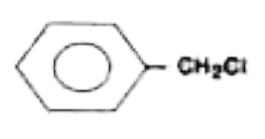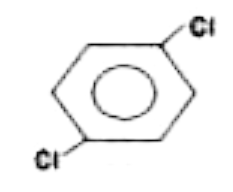Account for the following:
Aryl cyanides cannot be formed by the reaction of aryl halides and sodium cyanide.
To explain why aryl cyanides cannot be formed by the reaction of aryl halides with sodium cyanide, we can break down the reasoning into several steps:
1. Understanding the Reaction:
- Aryl halides (like chlorobenzene) are compounds where a halogen atom is directly bonded to an aromatic ring. Sodium cyanide (NaCN) is a source of the cyanide ion (CN⁻), which acts as a nucleophile.
2. Nucleophilic Substitution Mechanism:
- In typical nucleophilic substitution reactions, the nucleophile attacks the carbon atom bonded to the leaving group (the halogen in this case), resulting in the substitution of the halogen with the nucleophile.
3. Example of Alkyl Halides:
- When alkyl halides (like alkyl chlorides) react with sodium cyanide, the nucleophile (CN⁻) can easily attack the carbon atom, leading to the formation of alkyl cyanides. This is because the carbon-halogen bond in alkyl halides is relatively weak and can be broken easily.
4. Stability of Aryl Halides:
- In contrast, aryl halides have a carbon-halogen bond that is significantly stronger due to resonance stabilization. For example, in chlorobenzene, the chlorine atom can delocalize its lone pair of electrons into the aromatic ring, creating resonance structures. This delocalization leads to a partial double bond character between the carbon and the chlorine.
5. Partial Double Bond Character:
- The presence of this partial double bond character makes the C-Cl bond in aryl halides much stronger and more stable than in alkyl halides. As a result, the bond does not easily break, preventing the nucleophile from attacking the carbon atom.
6. Conclusion:
- Therefore, when sodium cyanide is added to aryl halides, the strong and stable C-Cl bond does not undergo nucleophilic substitution, and as a result, aryl cyanides cannot be formed.
Final Answer:
Aryl cyanides cannot be formed by the reaction of aryl halides with sodium cyanide because the C-Cl bond in aryl halides is stabilized by resonance, which gives it partial double bond character, making it stronger and less reactive towards nucleophilic attack compared to alkyl halides.
- Aryl halides (like chlorobenzene) are compounds where a halogen atom is directly bonded to an aromatic ring. Sodium cyanide (NaCN) is a source of the cyanide ion (CN⁻), which acts as a nucleophile.
- In typical nucleophilic substitution reactions, the nucleophile attacks the carbon atom bonded to the leaving group (the halogen in this case), resulting in the substitution of the halogen with the nucleophile.
- When alkyl halides (like alkyl chlorides) react with sodium cyanide, the nucleophile (CN⁻) can easily attack the carbon atom, leading to the formation of alkyl cyanides. This is because the carbon-halogen bond in alkyl halides is relatively weak and can be broken easily.
- In contrast, aryl halides have a carbon-halogen bond that is significantly stronger due to resonance stabilization. For example, in chlorobenzene, the chlorine atom can delocalize its lone pair of electrons into the aromatic ring, creating resonance structures. This delocalization leads to a partial double bond character between the carbon and the chlorine.
- The presence of this partial double bond character makes the C-Cl bond in aryl halides much stronger and more stable than in alkyl halides. As a result, the bond does not easily break, preventing the nucleophile from attacking the carbon atom.
- Therefore, when sodium cyanide is added to aryl halides, the strong and stable C-Cl bond does not undergo nucleophilic substitution, and as a result, aryl cyanides cannot be formed.
Aryl cyanides cannot be formed by the reaction of aryl halides with sodium cyanide because the C-Cl bond in aryl halides is stabilized by resonance, which gives it partial double bond character, making it stronger and less reactive towards nucleophilic attack compared to alkyl halides.
Topper's Solved these Questions
- HALOALKANES AND HALOARENES BOOK - ICSECHAPTER - HALOALKANES AND HALOARENES EXERCISE - EXERCISE (PART - II DESCRIPTIVE QUESTIONS) (LONG ANSWER QUESTIONS)
65 Videos
- HALOALKANES AND HALOARENES BOOK - ICSECHAPTER - HALOALKANES AND HALOARENES EXERCISE - ISC EXAMINATION QUESTIONS
4 Videos
- HALOALKANES AND HALOARENES BOOK - ICSECHAPTER - HALOALKANES AND HALOARENES EXERCISE - EXERCISE (PART - II DESCRIPTIVE QUESTIONS) (VERY SHORT ANSWER QUESTIONS)
83 Videos
- GENERAL PRINCIPLES AND PROCESSES OF ISOLATION OF ELEMENTS BOOK - ICSECHAPTER - GENERAL PRINCIPLES AND PROCESSES OF ISOLATION OF ELEMENTS EXERCISE - EXERCISE (PART-I ( OBJECTIVE QUESTIONS )) (Fill in the blanks)
60 Videos
- ISC QUESTION PAPERBOOK - ICSECHAPTER - ISC QUESTION PAPEREXERCISE - PART-II(SECTION-B)
74 Videos
Similar Questions
Knowledge Check
Aryl halide undergo :
AFittig reactionBUlmann reactionCWurtz reactionDGrignard reagent synthesisWhich of the following is an aryl alkyl halide.
A B
B C
C DNone of these
DNone of theseWhich one of the following is not the correct order of boiling points of alkyl / aryl halides ?
ACHCl3>CH2Cl2BCH3(CH2)3Cl>CH3(CH2)2ClC(CH3)3Cl>(CH3)2CHCH2ClDCH3(CH2)3Cl>CH2CH2CHClCH3
Which of the following halides cannot be hydrolysed?
View SolutionWhich of the following halide cannot hydrolysed ?
View SolutionDo the following conversions.
Ethyl cyanide to ethylamine
View SolutionWhich of the following is/are correct for cyanide process of extraction of gold?
View SolutionWhich of the following compounds can be classified as aryl halides ?
View Solution
